Bladder Cancer Treatment (PDQ®): Treatment – Patient Information [NCI]
This information is produced and provided by the National Cancer Institute (NCI). The information in this topic may have changed since it was written. For the most current information, contact the National Cancer Institute via the Internet web site at http://cancer.gov or call 1-800-4-CANCER.
General Information About Bladder Cancer
Bladder cancer is a disease in which malignant (cancer) cells form in the tissues of the bladder.
The bladder is a hollow organ in the lower part of the abdomen. It is shaped like a small balloon and has a muscular wall that allows it to get larger or smaller to store urine made by the kidneys. There are two kidneys, one on each side of the backbone, above the waist. Tiny tubules in the kidneys filter and clean the blood. They take out waste products and make urine. The urine passes from each kidney through a long tube called a ureter into the bladder. The bladder holds the urine until it passes through the urethra and leaves the body.
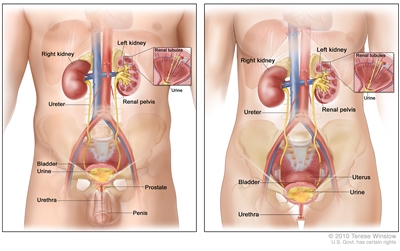
Anatomy of the male urinary system (left panel) and female urinary system (right panel) showing the kidneys, ureters, bladder, and urethra. Urine is made in the renal tubules and collects in the renal pelvis of each kidney. The urine flows from the kidneys through the ureters to the bladder. The urine is stored in the bladder until it leaves the body through the urethra.
There are three types of bladder cancer that begin in cells in the lining of the bladder. These cancers are named for the type of cells that become malignant (cancerous):
- Transitional cell carcinoma: Cancer that begins in cells in the innermost tissue layer of the bladder. These cells are able to stretch when the bladder is full and shrink when it is emptied. Most bladder cancers begin in the transitional cells. Transitional cell carcinoma can be low-grade or high-grade:
- Low-grade transitional cell carcinoma often recurs (comes back) after treatment, but rarely spreads into the muscle layer of the bladder or to other parts of the body.
- High-grade transitional cell carcinoma often recurs (comes back) after treatment and often spreads into the muscle layer of the bladder, to other parts of the body, and to lymph nodes. Almost all deaths from bladder cancer are due to high-grade disease.
- Squamous cell carcinoma: Cancer that begins in squamous cells (thin, flat cells lining the inside of the bladder). Cancer may form after long-term infection or irritation.
- Adenocarcinoma: Cancer that begins in glandular cells that are found in the lining of the bladder. Glandular cells in the bladder make substances such as mucus. This is a very rare type of bladder cancer.
Cancer that is in the lining of the bladder is called superficial bladder cancer. Cancer that has spread through the lining of the bladder and invades the muscle wall of the bladder or has spread to nearby organs and lymph nodes is called invasive bladder cancer.
See the following PDQ summaries for more information:
- Renal Cell Cancer Treatment
- Transitional Cell Cancer of the Renal Pelvis and Ureter Treatment
- Bladder and Other Urothelial Cancers Screening
- Unusual Cancers of Childhood Treatment
Smoking can affect the risk of bladder cancer.
Anything that increases your chance of getting a disease is called a risk factor. Having a risk factor does not mean that you will get cancer; not having risk factors doesn’t mean that you will not get cancer. Talk to your doctor if you think you may be at risk for bladder cancer.
Risk factors for bladder cancer include the following:
- Using tobacco, especially smoking cigarettes.
- Having a family history of bladder cancer.
- Having certain changes in the genes that are linked to bladder cancer.
- Being exposed to paints, dyes, metals, or petroleum products in the workplace.
- Past treatment with radiation therapy to the pelvis or with certain anticancer drugs, such as cyclophosphamide or ifosfamide.
- Taking Aristolochia fangchi, a Chinese herb.
- Drinking water from a well that has high levels of arsenic.
- Drinking water that has been treated with chlorine.
- Having a history of bladder infections, including bladder infections caused by Schistosoma haematobium.
- Using urinary catheters for a long time.
Older age is a risk factor for most cancers. The chance of getting cancer increases as you get older.
Signs and symptoms of bladder cancer include blood in the urine and pain during urination.
These and other signs and symptoms may be caused by bladder cancer or by other conditions. Check with your doctor if you have any of the following:
- Blood in the urine (slightly rusty to bright red in color).
- Frequent urination.
- Pain during urination.
- Lower back pain.
Tests that examine the urine and bladder are used to help detect (find) and diagnose bladder cancer.
The following tests and procedures may be used:
- Physical exam and history: An exam of the body to check general signs of health, including checking for signs of disease, such as lumps or anything else that seems unusual. A history of the patient’s health habits and past illnesses and treatments will also be taken.
- Internal exam: An exam of the vagina and/or rectum. The doctor inserts lubricated, gloved fingers into the vagina and/or rectum to feel for lumps.
- Urinalysis: A test to check the color of urine and its contents, such as sugar, protein, red blood cells, and white blood cells.
- Urine cytology: A laboratory test in which a sample of urine is checked under a microscope for abnormal cells.
- Cystoscopy: A procedure to look inside the bladder and urethra to check for abnormal areas. A cystoscope is inserted through the urethra into the bladder. A cystoscope is a thin, tube-like instrument with a light and a lens for viewing. It may also have a tool to remove tissue samples, which are checked under a microscope for signs of cancer.

Cystoscopy. A cystoscope (a thin, tube-like instrument with a light and a lens for viewing) is inserted through the urethra into the bladder. Fluid is used to fill the bladder. The doctor looks at an image of the inner wall of the bladder on a computer monitor. - Intravenous pyelogram (IVP): A series of x-rays of the kidneys, ureters, and bladder to find out if cancer is present in these organs. A contrast dye is injected into a vein. As the contrast dye moves through the kidneys, ureters, and bladder, x-rays are taken to see if there are any blockages.
- Biopsy: The removal of cells or tissues so they can be viewed under a microscope by a pathologist to check for signs of cancer. A biopsy for bladder cancer is usually done during cystoscopy. It may be possible to remove the entire tumor during biopsy.
Certain factors affect prognosis (chance of recovery) and treatment options.
The prognosis (chance of recovery) depends on the following:
- The stage of the cancer (whether it is superficial or invasive bladder cancer, and whether it has spread to other places in the body). Bladder cancer in the early stages can often be cured.
- The type of bladder cancer cells and how they look under a microscope.
- Whether there is carcinoma in situ in other parts of the bladder.
- The patient’s age and general health.
If the cancer is superficial, prognosis also depends on the following:
- How many tumors there are.
- The size of the tumors.
- Whether the tumor has recurred (come back) after treatment.
Treatment options depend on the stage of bladder cancer.
Stages of Bladder Cancer
After bladder cancer has been diagnosed, tests are done to find out if cancer cells have spread within the bladder or to other parts of the body.
The process used to find out if cancer has spread within the bladder lining and muscle or to other parts of the body is called staging. The information gathered from the staging process determines the stage of the disease. It is important to know the stage in order to plan treatment. The following tests and procedures may be used in the staging process:
- CT scan (CAT scan): A procedure that makes a series of detailed pictures of areas inside the body, taken from different angles. The pictures are made by a computer linked to an x-ray machine. A dye may be injected into a vein or swallowed to help the organs or tissues show up more clearly. This procedure is also called computed tomography, computerized tomography, or computerized axial tomography. To stage bladder cancer, the CT scan may take pictures of the chest, abdomen, and pelvis.
- MRI (magnetic resonance imaging): A procedure that uses a magnet, radio waves, and a computer to make a series of detailed pictures of areas inside the body, such as the brain. This procedure is also called nuclear magnetic resonance imaging (NMRI).
- PET scan (positron emission tomography scan): A procedure to find malignant tumor cells in the body. A small amount of radioactive glucose (sugar) is injected into a vein. The PET scanner rotates around the body and makes a picture of where glucose is being used in the body. Malignant tumor cells show up brighter in the picture because they are more active and take up more glucose than normal cells do. This procedure is done to check whether there are malignant tumor cells in the lymph nodes.
- Chest x-ray: An x-ray of the organs and bones inside the chest. An x-ray is a type of energy beam that can go through the body and onto film, making a picture of areas inside the body.
- Bone scan: A procedure to check if there are rapidly dividing cells, such as cancer cells, in the bone. A very small amount of radioactive material is injected into a vein and travels through the bloodstream. The radioactive material collects in the bones with cancer and is detected by a scanner.
There are three ways that cancer spreads in the body.
Cancer can spread through tissue, the lymph system, and the blood:
- Tissue. The cancer spreads from where it began by growing into nearby areas.
- Lymph system. The cancer spreads from where it began by getting into the lymph system. The cancer travels through the lymph vessels to other parts of the body.
- Blood. The cancer spreads from where it began by getting into the blood. The cancer travels through the blood vessels to other parts of the body.
Cancer may spread from where it began to other parts of the body.
When cancer spreads to another part of the body, it is called metastasis. Cancer cells break away from where they began (the primary tumor) and travel through the lymph system or blood.
- Lymph system. The cancer gets into the lymph system, travels through the lymph vessels, and forms a tumor (metastatic tumor) in another part of the body.
- Blood. The cancer gets into the blood, travels through the blood vessels, and forms a tumor (metastatic tumor) in another part of the body.
The metastatic tumor is the same type of cancer as the primary tumor. For example, if bladder cancer spreads to the bone, the cancer cells in the bone are actually bladder cancer cells. The disease is metastatic bladder cancer, not bone cancer.
The following stages are used for bladder cancer:
Stage 0 (Noninvasive Papillary Carcinoma and Carcinoma in Situ)
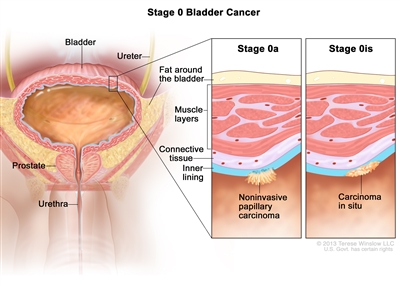
Stage 0 bladder cancer. Abnormal cells are found in the tissue lining the inside of the bladder. Stage 0a (also called noninvasive papillary carcinoma) may look like long, thin growths growing from the lining of the bladder. Stage 0is (also called carcinoma in situ) is a flat tumor on the tissue lining the inside of the bladder.
In stage 0, abnormal cells are found in tissue lining the inside of the bladder. These abnormal cells may become cancer and spread into nearby normal tissue. Stage 0 is divided into stages 0a and 0is, depending on the type of the tumor:
- Stage 0a is also called noninvasive papillary carcinoma, which may look like long, thin growths growing from the lining of the bladder.
- Stage 0is is also called carcinoma in situ, which is a flat tumor on the tissue lining the inside of the bladder.
Stage I
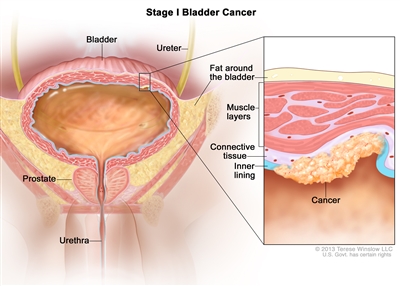
Stage I bladder cancer. Cancer has spread to the layer of connective tissue next to the inner lining of the bladder.
In stage I, cancer has formed and spread to the layer of connective tissue next to the inner lining of the bladder.
Stage II
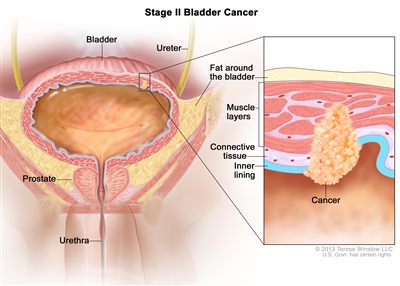
Stage II bladder cancer. Cancer has spread to the layers of muscle tissue of the bladder.
In stage II, cancer has spread to the layers of muscle tissue of the bladder.
Stage III
Stage III is divided into stages IIIA and IIIB.
- In stage IIIA:
- cancer has spread from the bladder to the layer of fat surrounding the bladder and may have spread to the reproductive organs (prostate, seminal vesicles, uterus, or vagina) and cancer has not spread to lymph nodes; or
- cancer has spread from the bladder to one lymph node in the pelvis that is not near the common iliac arteries (major arteries in the pelvis).
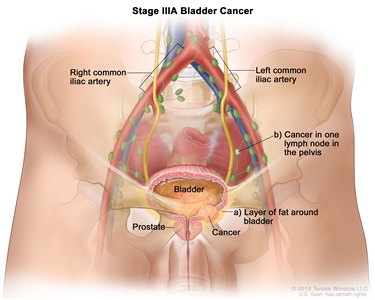
Stage IIIA bladder cancer. Cancer has spread from the bladder to (a) the layer of fat around the bladder and may have spread to the prostate and/or seminal vesicles in men or the uterus and/or vagina in women, and cancer has not spread to lymph nodes; or (b) one lymph node in the pelvis that is not near the common iliac arteries. - In stage IIIB, cancer has spread from the bladder to more than one lymph node in the pelvis that is not near the common iliac arteries or to at least one lymph node that is near the common iliac arteries.
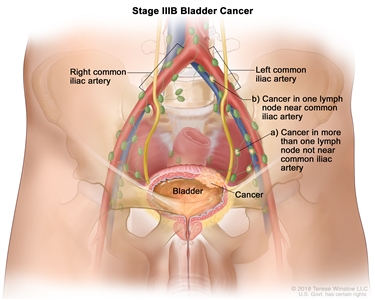
Stage IIIB bladder cancer. Cancer has spread from the bladder to (a) more than one lymph node in the pelvis that is not near the common iliac arteries; or (b) at least one lymph node that is near the common iliac arteries.
Stage IV
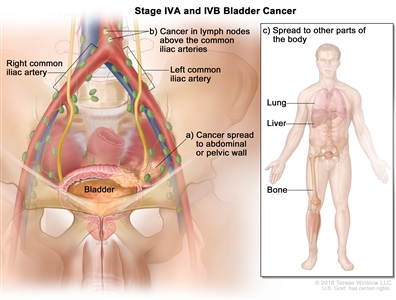
Stage IVA and IVB bladder cancer. In stage IVA, cancer has spread from the bladder to (a) the wall of the abdomen or pelvis; or (b) lymph nodes above the common iliac arteries. In stage IVB, cancer has spread to (c) other parts of the body, such as the lung, liver, or bone.
Stage IV is divided into stages IVA and IVB.
- In stage IVA:
- cancer has spread from the bladder to the wall of the abdomen or pelvis; or
- cancer has spread to lymph nodes that are above the common iliac arteries (major arteries in the pelvis).
- In stage IVB, cancer has spread to other parts of the body, such as the lung, bone, or liver.
Recurrent Bladder Cancer
Recurrent bladder cancer is cancer that has recurred (come back) after it has been treated. The cancer may come back in the bladder or in other parts of the body.
Treatment Option Overview
There are different types of treatment for patients with bladder cancer.
Different types of treatment are available for patients with bladder cancer. Some treatments are standard (the currently used treatment), and some are being tested in clinical trials. A treatment clinical trial is a research study meant to help improve current treatments or obtain information on new treatments for patients with cancer. When clinical trials show that a new treatment is better than the standard treatment, the new treatment may become the standard treatment. Patients may want to think about taking part in a clinical trial. Some clinical trials are open only to patients who have not started treatment.
Four types of standard treatment are used:
Surgery
One of the following types of surgery may be done:
- Transurethral resection (TUR) with fulguration: Surgery in which a cystoscope (a thin lighted tube) is inserted into the bladder through the urethra. A tool with a small wire loop on the end is then used to remove the cancer or to burn the tumor away with high-energy electricity. This is known as fulguration.
- Radical cystectomy: Surgery to remove the bladder and any lymph nodes and nearby organs that contain cancer. This surgery may be done when the bladder cancer invades the muscle wall, or when superficial cancer involves a large part of the bladder. In men, the nearby organs that are removed are the prostate and the seminal vesicles. In women, the uterus, the ovaries, and part of the vagina are removed. Sometimes, when the cancer has spread outside the bladder and cannot be completely removed, surgery to remove only the bladder may be done to reduce urinary symptoms caused by the cancer. When the bladder must be removed, the surgeon creates another way for urine to leave the body.
- Partial cystectomy: Surgery to remove part of the bladder. This surgery may be done for patients who have a low-grade tumor that has invaded the wall of the bladder but is limited to one area of the bladder. Because only a part of the bladder is removed, patients are able to urinate normally after recovering from this surgery. This is also called segmental cystectomy.
- Urinary diversion: Surgery to make a new way for the body to store and pass urine.
After the doctor removes all the cancer that can be seen at the time of the surgery, some patients may be given chemotherapy after surgery to kill any cancer cells that are left. Treatment given after surgery, to lower the risk that the cancer will come back, is called adjuvant therapy.
Radiation therapy
Radiation therapy is a cancer treatment that uses high-energy x-rays or other types of radiation to kill cancer cells or keep them from growing. There are two types of radiation therapy:
- External radiation therapy uses a machine outside the body to send radiation toward the cancer.
- Internal radiation therapy uses a radioactive substance sealed in needles, seeds, wires, or catheters that are placed directly into or near the cancer.
The way the radiation therapy is given depends on the type and stage of the cancer being treated. External radiation therapy is used to treat bladder cancer.
Chemotherapy
Chemotherapy is a cancer treatment that uses drugs to stop the growth of cancer cells, either by killing the cells or by stopping them from dividing. When chemotherapy is taken by mouth or injected into a vein or muscle, the drugs enter the bloodstream and can reach cancer cells throughout the body (systemic chemotherapy). When chemotherapy is placed directly into the cerebrospinal fluid, an organ, or a body cavity such as the abdomen, the drugs mainly affect cancer cells in those areas (regional chemotherapy). For bladder cancer, regional chemotherapy may be intravesical (put into the bladder through a tube inserted into the urethra). The way the chemotherapy is given depends on the type and stage of the cancer being treated. Combination chemotherapy is treatment using more than one anticancer drug.
See Drugs Approved for Bladder Cancer for more information.
Immunotherapy
Immunotherapy is a treatment that uses the patient’s immune system to fight cancer. Substances made by the body or made in a laboratory are used to boost, direct, or restore the body’s natural defenses against cancer. This type of cancer treatment is also called biotherapy or biologic therapy.
There are different types of immunotherapy:
- Immune checkpoint inhibitor therapy: PD-1 inhibitors are a type of immune checkpoint inhibitor therapy used in the treatment of bladder cancer. PD-1 is a protein on the surface of T cells that helps keep the body’s immune responses in check. When PD-1 attaches to another protein called PDL-1 on a cancer cell, it stops the T cell from killing the cancer cell. PD-1 inhibitors attach to PDL-1 and allow the T cells to kill cancer cells. Pembrolizumab, atezolizumab, nivolumab, avelumab, and durvalumab are types of PD-1 inhibitors.

Immune checkpoint inhibitor. Checkpoint proteins, such as PD-L1 on tumor cells and PD-1 on T cells, help keep immune responses in check. The binding of PD-L1 to PD-1 keeps T cells from killing tumor cells in the body (left panel). Blocking the binding of PD-L1 to PD-1 with an immune checkpoint inhibitor (anti-PD-L1 or anti-PD-1) allows the T cells to kill tumor cells (right panel).
- BCG (bacillus Calmette-Guérin): Bladder cancer may be treated with an intravesical immunotherapy called BCG. The BCG is given in a solution that is placed directly into the bladder using a catheter (thin tube).
See Drugs Approved for Bladder Cancer for more information.
New types of treatment are being tested in clinical trials.
Information about clinical trials is available from the NCI website.
Treatment for bladder cancer may cause side effects.
For information about side effects caused by treatment for cancer, see our Side Effects page.
Patients may want to think about taking part in a clinical trial.
For some patients, taking part in a clinical trial may be the best treatment choice. Clinical trials are part of the cancer research process. Clinical trials are done to find out if new cancer treatments are safe and effective or better than the standard treatment.
Many of today’s standard treatments for cancer are based on earlier clinical trials. Patients who take part in a clinical trial may receive the standard treatment or be among the first to receive a new treatment.
Patients who take part in clinical trials also help improve the way cancer will be treated in the future. Even when clinical trials do not lead to effective new treatments, they often answer important questions and help move research forward.
Patients can enter clinical trials before, during, or after starting their cancer treatment.
Some clinical trials only include patients who have not yet received treatment. Other trials test treatments for patients whose cancer has not gotten better. There are also clinical trials that test new ways to stop cancer from recurring (coming back) or reduce the side effects of cancer treatment.
Clinical trials are taking place in many parts of the country. Information about clinical trials supported by NCI can be found on NCI’s clinical trials search webpage. Clinical trials supported by other organizations can be found on the ClinicalTrials.gov website.
Follow-up tests may be needed.
Some of the tests that were done to diagnose the cancer or to find out the stage of the cancer may be repeated. Some tests will be repeated in order to see how well the treatment is working. Decisions about whether to continue, change, or stop treatment may be based on the results of these tests.
Some of the tests will continue to be done from time to time after treatment has ended. The results of these tests can show if your condition has changed or if the cancer has recurred (come back). These tests are sometimes called follow-up tests or check-ups.
Bladder cancer often recurs (comes back), even when the cancer is superficial. Surveillance of the urinary tract to check for recurrence is standard after a diagnosis of bladder cancer. Surveillance is closely watching a patient’s condition but not giving any treatment unless there are changes in test results that show the condition is getting worse. During active surveillance, certain exams and tests are done on a regular schedule. Surveillance may include ureteroscopy and imaging tests. See staging tests, above.
Treatment Options by Stage
For information about the treatments listed below, see the Treatment Option Overview section.
Stage 0 (Noninvasive Papillary Carcinoma and Carcinoma in Situ)
Treatment of stage 0 (noninvasive papillary carcinoma and carcinoma in situ) may include the following:
- Transurethral resection with fulguration. This may be followed by one of the following:
- Intravesical chemotherapy given right after surgery.
- Intravesical chemotherapy given right after surgery and then regular treatments with intravesical BCG or intravesical chemotherapy.
- Partial cystectomy.
- Radical cystectomy.
- A clinical trial of a new treatment.
Use our clinical trial search to find NCI-supported cancer clinical trials that are accepting patients. You can search for trials based on the type of cancer, the age of the patient, and where the trials are being done. General information about clinical trials is also available.
Stage I Bladder Cancer
Treatment of stage I bladder cancer may include the following:
- Transurethral resection with fulguration. This may be followed by one of the following:
- Intravesical chemotherapy given right after surgery.
- Intravesical chemotherapy given right after surgery and then regular treatments with intravesical BCG or intravesical chemotherapy.
- Partial cystectomy.
- Radical cystectomy.
- A clinical trial of a new treatment.
Use our clinical trial search to find NCI-supported cancer clinical trials that are accepting patients. You can search for trials based on the type of cancer, the age of the patient, and where the trials are being done. General information about clinical trials is also available.
Stages II and III Bladder Cancer
Treatment of stages II and III bladder cancer may include the following:
- Radical cystectomy.
- Combination chemotherapy followed by radical cystectomy. A urinary diversion may be done.
- External radiation therapy with or without chemotherapy.
- Partial cystectomy with or without chemotherapy.
- Transurethral resection with fulguration.
- A clinical trial of a new treatment.
Use our clinical trial search to find NCI-supported cancer clinical trials that are accepting patients. You can search for trials based on the type of cancer, the age of the patient, and where the trials are being done. General information about clinical trials is also available.
Stage IV Bladder Cancer
Treatment of stage IV bladder cancer that has not spread to other parts of the body may include the following:
- Chemotherapy.
- Radical cystectomy alone or followed by chemotherapy.
- External radiation therapy with or without chemotherapy.
- Urinary diversion or cystectomy as palliative therapy to relieve symptoms and improve quality of life.
Treatment of stage IV bladder cancer that has spread to other parts of the body, such as the lung, bone, or liver, may include the following:
- Chemotherapy with or without local treatment (surgery or radiation therapy).
- Immunotherapy (immune checkpoint inhibitor therapy).
- External radiation therapy as palliative therapy to relieve symptoms and improve quality of life.
- Urinary diversion or cystectomy as palliative therapy to relieve symptoms and improve quality of life.
- A clinical trial of new anticancer drugs.
Use our clinical trial search to find NCI-supported cancer clinical trials that are accepting patients. You can search for trials based on the type of cancer, the age of the patient, and where the trials are being done. General information about clinical trials is also available.
Treatment Options for Recurrent Bladder Cancer
For information about the treatments listed below, see the Treatment Option Overview section.
Treatment of recurrent bladder cancer depends on previous treatment and where the cancer has recurred. Treatment for recurrent bladder cancer may include the following:
- Combination chemotherapy.
- Immunotherapy (immune checkpoint inhibitor therapy).
- Surgery for superficial or localized tumors. Surgery may be followed by biologic therapy and/or chemotherapy.
- Radiation therapy as palliative therapy to relieve symptoms and improve quality of life.
- A clinical trial of a new treatment.
Use our clinical trial search to find NCI-supported cancer clinical trials that are accepting patients. You can search for trials based on the type of cancer, the age of the patient, and where the trials are being done. General information about clinical trials is also available.
To Learn More About Bladder Cancer
For more information from the National Cancer Institute about bladder cancer, see the following:
- Bladder Cancer Home Page
- Bladder and Other Urothelial Cancers Screening
- Unusual Cancers of Childhood Treatment
- Drugs Approved for Bladder Cancer
- Biological Therapies for Cancer
- Tobacco (includes help with quitting)
For general cancer information and other resources from the National Cancer Institute, see the following:
- About Cancer
- Staging
- Chemotherapy and You: Support for People With Cancer
- Radiation Therapy and You: Support for People With Cancer
- Coping with Cancer
- Questions to Ask Your Doctor about Cancer
- For Survivors and Caregivers
About This PDQ Summary
About PDQ
Physician Data Query (PDQ) is the National Cancer Institute’s (NCI’s) comprehensive cancer information database. The PDQ database contains summaries of the latest published information on cancer prevention, detection, genetics, treatment, supportive care, and complementary and alternative medicine. Most summaries come in two versions. The health professional versions have detailed information written in technical language. The patient versions are written in easy-to-understand, nontechnical language. Both versions have cancer information that is accurate and up to date and most versions are also available in Spanish.
PDQ is a service of the NCI. The NCI is part of the National Institutes of Health (NIH). NIH is the federal government’s center of biomedical research. The PDQ summaries are based on an independent review of the medical literature. They are not policy statements of the NCI or the NIH.
Purpose of This Summary
This PDQ cancer information summary has current information about the treatment of bladder cancer. It is meant to inform and help patients, families, and caregivers. It does not give formal guidelines or recommendations for making decisions about health care.
Reviewers and Updates
Editorial Boards write the PDQ cancer information summaries and keep them up to date. These Boards are made up of experts in cancer treatment and other specialties related to cancer. The summaries are reviewed regularly and changes are made when there is new information. The date on each summary (“Updated”) is the date of the most recent change.
The information in this patient summary was taken from the health professional version, which is reviewed regularly and updated as needed, by the PDQ Adult Treatment Editorial Board.
Clinical Trial Information
A clinical trial is a study to answer a scientific question, such as whether one treatment is better than another. Trials are based on past studies and what has been learned in the laboratory. Each trial answers certain scientific questions in order to find new and better ways to help cancer patients. During treatment clinical trials, information is collected about the effects of a new treatment and how well it works. If a clinical trial shows that a new treatment is better than one currently being used, the new treatment may become “standard.” Patients may want to think about taking part in a clinical trial. Some clinical trials are open only to patients who have not started treatment.
Clinical trials can be found online at NCI’s website. For more information, call the Cancer Information Service (CIS), NCI’s contact center, at 1-800-4-CANCER (1-800-422-6237).
Permission to Use This Summary
PDQ is a registered trademark. The content of PDQ documents can be used freely as text. It cannot be identified as an NCI PDQ cancer information summary unless the whole summary is shown and it is updated regularly. However, a user would be allowed to write a sentence such as “NCI’s PDQ cancer information summary about breast cancer prevention states the risks in the following way: [include excerpt from the summary].”
The best way to cite this PDQ summary is:
PDQ® Adult Treatment Editorial Board. PDQ Bladder Cancer Treatment. Bethesda, MD: National Cancer Institute. Updated <MM/DD/YYYY>. Available at: https://www.cancer.gov/types/bladder/patient/bladder-treatment-pdq. Accessed <MM/DD/YYYY>. [PMID: 26389479]
Images in this summary are used with permission of the author(s), artist, and/or publisher for use in the PDQ summaries only. If you want to use an image from a PDQ summary and you are not using the whole summary, you must get permission from the owner. It cannot be given by the National Cancer Institute. Information about using the images in this summary, along with many other images related to cancer can be found in Visuals Online. Visuals Online is a collection of more than 3,000 scientific images.
Disclaimer
The information in these summaries should not be used to make decisions about insurance reimbursement. More information on insurance coverage is available on Cancer.gov on the Managing Cancer Care page.
Contact Us
More information about contacting us or receiving help with the Cancer.gov website can be found on our Contact Us for Help page. Questions can also be submitted to Cancer.gov through the website’s E-mail Us.
Last Revised: 2018-12-27
If you want to know more about cancer and how it is treated, or if you wish to know about clinical trials for your type of cancer, you can call the NCI’s Cancer Information Service at 1-800-422-6237, toll free. A trained information specialist can talk with you and answer your questions.
This information does not replace the advice of a doctor. Healthwise, Incorporated, disclaims any warranty or liability for your use of this information. Your use of this information means that you agree to the Terms of Use. Learn how we develop our content.

